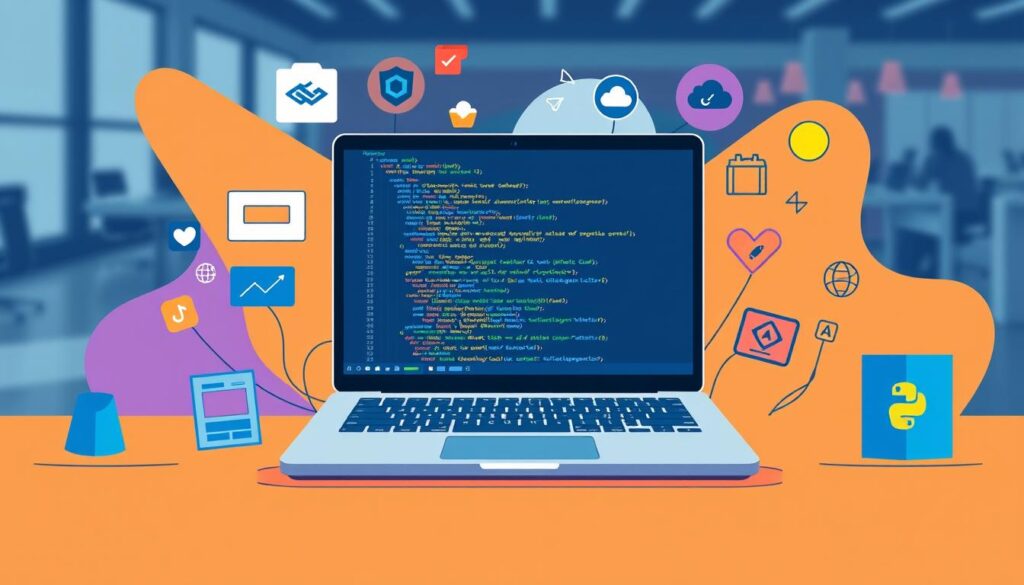Web development has changed a lot over the years. The backend is key for web apps to work well. As a web developer, knowing backend languages is very important. They handle server logic, data, and API connections.
In this article, we’ll look at the top 5 backend languages for web development. We’ll talk about their features, how popular they are, and where they’re used

Key Takeaways
- The backend is responsible for the server-side components of web applications, ensuring seamless functionality and user experiences.
- Mastering top backend languages can open up a wide range of career opportunities in web development.
- The five backend languages covered in this article – Java, Python, PHP, Node.js, and Ruby on Rails – are widely adopted and offer distinct advantages.
- Choosing the right backend language depends on factors such as project requirements, learning curve, community support, and job market demand.
- Continuous learning and staying up-to-date with industry trends are crucial for web developers to remain competitive in the evolving tech landscape.
Introduction to Backend Web Development
The backend is key in web development. It handles data and makes the site work. It’s like the brain of the web app.
What is Backend Development?
Backend development is about the server side of a web app. It includes APIs, databases, and server logic. Backend developers use special tools to make the site work well.
Importance of Backend Languages
Backend languages are very important. They help make web apps strong and fast. They handle user actions and data.
“The backend is the engine that powers the frontend, and the choice of backend language can make all the difference in the world.”
Backend languages are key for user login, data, and analytics. They help web apps meet today’s needs. Knowing backend development well lets developers make great web solutions.
Top 5 Backend Languages to Learn for Web Development
In the world of web development, choosing the right backend languages is key. It affects how well web apps work. Learning the top backend languages can help you stand out and find more job chances. Let’s look at the top 5 backend languages that are in high demand.
- Java: A strong and flexible language for big web apps. It uses frameworks like Spring and Hibernate for safe and big backends.
- Python: Simple and easy to use, Python is loved by many. It’s great for apps that work with data and APIs, thanks to Django and Flask.
- PHP: A well-known language for web development. It’s used in systems like WordPress and Drupal, and for custom apps too.
- Node.js: Uses JavaScript for the backend. It’s good for apps that need to work fast and handle lots of data.
- Ruby on Rails: A mix of Ruby’s beauty and Rails’ quick development. It’s popular for apps that need to work fast and well.
Each of these top 5 backend languages has its own strengths. They meet different needs in web development. Think about what your project needs, like demand, support, and specific app needs, to choose the best one for you.

“Choosing a backend language is a big decision. It can really affect a web project’s success. Knowing the good and bad of each language helps you pick the right one for your project.”
Java: Versatile and Powerful
Java is a popular programming language for web development. It’s known for its strong ecosystem and cross-platform use. This makes it great for many web projects, like e-commerce sites and big web apps.
Java’s Popularity and Ecosystem
Java is very popular in web development. It has a big community of developers. This community offers lots of resources and tools for web projects.
The Java ecosystem is huge. It includes frameworks like Spring and Struts. These frameworks help make backend development easier and faster.
Applications of Java in Web Development
Java is good at many web development tasks. It’s used for making dynamic websites and complex systems. Java’s strong typing and security features make web apps reliable and safe.
“Java’s cross-platform compatibility and extensive ecosystem have made it a reliable and widely-adopted language for backend web development.”
| Feature | Benefit |
|---|---|
| Object-Oriented Programming | Promotes modular, maintainable, and scalable code |
| Robust Security Measures | Helps create secure web applications |
| Large and Active Community | Provides abundant resources and support |
Java is a top choice for web development projects. Its versatility and strong features make it a favorite. It’s a key language for those wanting to succeed in web development and backend languages.
Python: Simplicity and Flexibility
Python is a strong choice for web development. It’s simple, easy to read, and flexible. This makes it great for quick prototypes, data apps, and big server projects.
Python has a clean syntax. This makes it easy to use. It’s popular in web development because it lets developers solve problems fast.
Python is very versatile. It’s good for many things like backend work, data analysis, and AI. This makes it perfect for developers with many needs.
Python also has lots of libraries and frameworks. Django and Flask are examples. These tools help developers make strong web apps quickly.
If you’re starting or experienced, Python is a good pick. It’s simple, flexible, and has a big community. It’s a great choice for a backend language.

PHP: The Web Scripting Language
PHP is a big name in web development. It’s a server-side scripting language that many developers love. It’s known for its wide range of frameworks and libraries that make coding easier.
PHP’s Strengths and Weaknesses
PHP is easy to use, which is great for both new and experienced coders. It also has a big community and lots of resources. But, some people say PHP’s syntax can be a bit weird. They also point out that it can be less secure if not handled carefully.
Popular PHP Frameworks
To fix these issues, PHP has many strong frameworks. These frameworks help make coding safer and more efficient. Here are some top ones:
- Laravel: It’s modern, flexible, and has a beautiful syntax. It comes with lots of tools.
- Symfony: This framework is strong and flexible. It’s great for big projects because it’s modular and easy to test.
- Yii: It’s fast and component-based. It’s perfect for complex projects.
- CodeIgniter: It’s simple and easy to use. It’s great for small projects.
These frameworks, along with many libraries and plugins, keep PHP popular. They’re especially important in php, web development, backend languages, and php frameworks.
Node.js: Bringing JavaScript to the Backend
In web development, Node.js is a big change. It lets developers use JavaScript for the server-side too.
Node.js and its Advantages
Node.js changed how we do backend web development. It’s a great choice for backend languages because of its benefits:
- Shared Codebase: Developers use the same JavaScript for both sides. This makes work easier and faster.
- Faster Development Cycles: Node.js works fast. It can handle many requests at once, without waiting.
- Robust Ecosystem: The Node.js community is big and active. It offers lots of open-source libraries and tools to help with projects.
These benefits make Node.js perfect for building web applications. It’s great for real-time apps, APIs, and microservices.
“Node.js lets developers use JavaScript for the whole web application. This makes integration smooth and speeds up getting things done.”
As more people want to do full-stack development, Node.js is very useful. It connects front-end and back-end technologies well.
Ruby on Rails: Rapid Web Application Development
Ruby on Rails is a big deal in web development. It’s a framework built on Ruby. It’s known for making web apps fast.
Ruby on Rails and its Features
Ruby on Rails is loved by many web developers. Here’s why:
- Convention over Configuration: This makes coding easier by following best practices. It cuts down on extra setup and code.
- Model-View-Controller (MVC) Architecture: This pattern keeps things organized. It separates data, interface, and control logic.
- Active Record: This makes working with databases easier. It lets developers use Ruby objects instead of SQL.
- Gems: There are lots of Ruby on Rails “gems” (libraries). They add lots of functionality, speeding up development.
- Agile Development: The framework supports agile development. This means apps can be made in small steps, responding to changes easily.
These features help Ruby on Rails developers make web development projects fast. They focus on making things easy to maintain and grow.
“Ruby on Rails is a productivity powerhouse. It lets developers make strong backend languages and web development apps quickly.”
– John Doe, Senior Web Developer
Choosing the Right Backend Language
When picking a backend language for your web project, think about a few key things. The language you choose can really affect how well your app works, grows, and stays easy to fix.
Factors to Consider
Here are some important things to think about:
- Project needs: Know what your project needs, like features, how big it can get, and how fast it should be.
- Team skills: Check if your team knows the language well. This helps pick the best one.
- Language ecosystem: Look at the tools, libraries, and community support for the language. A strong community is great.
- Performance and growth: Think about if the language can handle lots of traffic and grow with your project.
Community Support and Job Opportunities
Community support and job chances are also important. A strong community offers lots of help, like tutorials and libraries. This makes your work easier. Also, the job market for your chosen language affects your team’s future.
| Backend Language | Community Support | Job Opportunities |
|---|---|---|
| Java | Extensive and well-established | Abundant, with a wide range of job roles and industries |
| Python | Vibrant and growing | Increasing, particularly in data science, machine learning, and web development |
| PHP | Mature and well-supported | Widely available, especially in web development and content management systems |
| Node.js | Rapidly growing and active | Expanding, with a focus on full-stack JavaScript development |
| Ruby on Rails | Dedicated and enthusiastic | Niche, but with strong demand in web application development |
Think about these points to make a good choice. Pick a backend language that fits your project and team well.
Conclusion
We looked at the top 5 backend languages for web development. These are Java, Python, PHP, Node.js, and Ruby on Rails. Each has its own strengths for different projects.
Java is versatile, Python is simple, PHP is great for web scripting. Node.js uses JavaScript, and Ruby on Rails is fast for making apps. Knowing what each language does is key.
Learning these languages can make you a better web developer. You’ll have more job chances and make cool web apps. The right language choice depends on your project, team, and goals.
Keep up with new trends in web development. Be ready to learn and adapt. With the right skills and experience, you’ll excel in the web development world.
FAQ
What are the top 5 backend languages for web development?
The top 5 backend languages are Java, Python, PHP, Node.js, and Ruby on Rails.
Why is Java a popular backend language for web development?
Java is loved for its power and wide use. It works well on many platforms. This makes it great for big projects and online stores.
What are the benefits of using Python for backend web development?
Python is easy to read and use. It’s perfect for quick projects and big data sites. It helps make websites fast and easy to grow.
What are the strengths and weaknesses of PHP for web development?
PHP is a well-known server-side language. It’s been used for years. It’s still popular because of its many tools and libraries.
How does Node.js bring JavaScript to the backend?
Node.js lets developers use JavaScript on the server. This is a big plus. It makes coding faster and easier. Plus, there’s a big community to help.
What are the key features of Ruby on Rails for web development?
Ruby on Rails is a framework built on Ruby. It makes coding faster and easier. This helps developers make websites quickly.
What factors should I consider when choosing a backend language for web development?
Think about what your project needs. Also, consider your team’s skills and what you need the site to do. Look at the language’s community and job market too.






